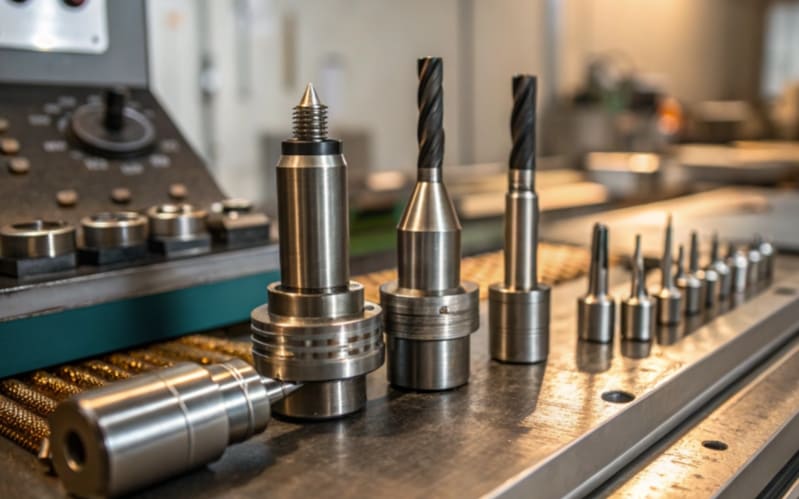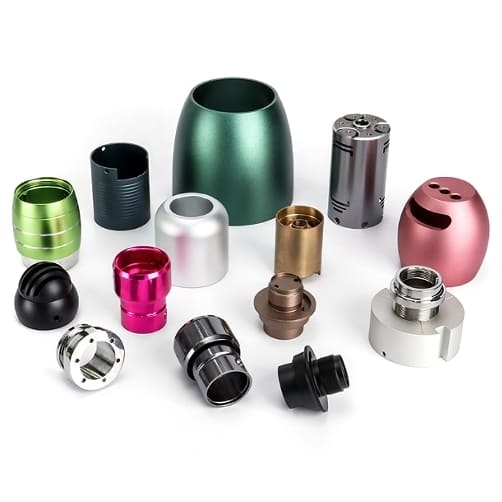When it comes to CNC machining plastics, choosing the right cutting tool can make or break the quality and efficiency of your production. Poor tool selection can lead to rough finishes, increased wear, and longer production times. So, how do you know which tools will give you the best results?
The best cutting tools for CNC plastic production are typically made from carbide, high-speed steel (HSS), or ceramic materials. Carbide tools offer durability and precision, especially for hard plastics. HSS tools are a more affordable option and are good for softer plastics.

Choosing the correct cutting tool depends on the type of plastic you’re working with, the cutting parameters, and the desired finish. Now, let’s explore some other important factors to keep in mind when choosing the right tools.
What plastic material can CNC machining?
CNC machining plastics can accommodate a wide variety of materials, but not all plastics are created equal. Understanding which plastics are best for machining is the first step.
Common plastics used in CNC machining include ABS, acrylic, polycarbonate, and nylon. Each material has unique properties that affect machining.

CNC machining can be done on various types of plastic, but the machinability differs depending on the material’s hardness, melting point, and flexibility. ABS is easy to machine, while polycarbonate requires careful handling due to its tendency to crack under pressure. Acrylic offers clear finishes but can be brittle, while nylon is tougher but prone to warping. Each material requires different tool types and cutting strategies.
ABS (Acrylonitrile Butadiene Styrene)
ABS is one of the most common plastics used in CNC machining due to its toughness and machinability. It is a favorite for creating complex geometric shapes in industries like automotive, electronics, and toys. It is easy to machine with standard tools, but care should be taken to avoid overheating and surface damage.
Polycarbonate (PC)
Polycarbonate is known for its transparency and impact resistance, but it is more challenging to machine than ABS. It tends to crack under pressure, so special care and tools are needed when cutting or drilling. A slower feed rate and a high-quality tool are essential for achieving smooth, crack-free surfaces.
Acrylic (PMMA)
Acrylic is widely used in sign-making and optical applications due to its clarity. It’s relatively easy to machine but can be brittle, requiring low speeds and feeds to avoid cracking or chipping. The edges of acrylic often require polishing after machining to achieve a smooth, high-quality finish.
Nylon
Nylon is a versatile engineering plastic often used in industries like automotive and industrial applications. It is tough and resistant to wear but tends to warp or distort when exposed to heat. Proper cooling and tool selection are key when machining nylon.
Which types of machining processes are good for plastics?
Different machining processes work better for certain types of plastic. Choosing the right process can ensure you avoid unnecessary mistakes and enhance the quality of your output.
Milling, turning, and drilling are the most common CNC processes used for plastics. These methods can be customized based on the plastic material.

Plastic machining can be done using several processes, including milling, turning, and drilling. Milling is particularly effective for creating complex shapes and fine details. Turning works well for cylindrical plastic parts, while drilling is used for precise hole creation. The key is to adjust your tool paths and cutting parameters for each process and material to ensure smooth results.
Milling
Milling is the most versatile process for plastic machining. It allows for the production of complex and intricate shapes, slots, and surfaces. When machining plastics, using a sharp tool and maintaining optimal speeds and feeds is essential to prevent melting or burr formation. Carbide tools are often preferred for milling tougher plastics like polycarbonate and PEEK.
Turning
Turning is ideal for cylindrical plastic parts and can produce high-quality surfaces with relatively low tool wear. It’s especially effective for plastics like nylon and acetal, which have good dimensional stability when turned. Precision turning often requires slower speeds to prevent overheating and to preserve the material’s structural integrity.
Drilling
Drilling is used to create holes in plastic materials. Special drill bits designed for plastics should be used to avoid cracking or melting. For materials like acrylic, a brad-point drill bit is recommended to reduce the chances of surface damage, while high-speed steel (HSS) tools can be sufficient for softer plastics like PVC.
How does the type of plastic affect the choice of cutting tools?
The type of plastic plays a significant role in choosing the right cutting tools. Not all plastics react the same way under heat and pressure, so knowing how to tailor your tools for each material is vital.
The hardness, brittleness, and melting point of the plastic determine which tools are most effective. Harder plastics require tools with specific coatings or materials to handle the heat generated during machining.

For example, soft plastics like PVC or polyethylene can be easily machined with high-speed steel (HSS) tools. On the other hand, harder plastics like polycarbonate or PEEK might require carbide tools or special coatings to prevent wear and overheating. The type of plastic affects the choice of tool material, geometry, and even speed settings, ensuring efficient and precise cutting.
Tough Plastics (e.g., PEEK, Polycarbonate)
These materials are durable but difficult to machine due to their hardness. Carbide tools are ideal for these applications, as they can withstand the stress and heat generated during cutting. Using specialized coatings such as titanium nitride (TiN) or diamond coatings can further increase tool life and improve finish quality.
Soft Plastics (e.g., PVC, Polyethylene)
For softer plastics, HSS tools or carbide tools with a sharp edge are usually sufficient. These materials are less demanding in terms of heat resistance and wear, so tools can operate at higher speeds and feeds. However, proper cooling and low feed rates should still be maintained to prevent deformation.
What are the best CNC cutting tools for specific plastic machining applications?
Choosing the right cutting tool for your specific application is essential to ensuring optimal results in CNC plastic machining. The best tool often depends on the complexity of the part and the plastic type.
For standard plastics, HSS tools are often adequate. However, for more advanced materials like PEEK or PTFE, carbide tools or those with special coatings might be necessary.
When machining plastics, tools with sharp edges and specific geometries are essential for preventing melting or uneven cuts. For simple, low-cost projects, high-speed steel (HSS) tools can work fine. However, for precision work with high-performance plastics like PEEK or PTFE, carbide tools are a better choice. The right tool will also depend on whether you’re milling, drilling, or turning the part, and whether you’re working with tough or brittle materials.
Special Coated Tools for Advanced Materials
For specialized applications, tools with advanced coatings like TiN (Titanium Nitride) coating or DLC (diamond-like carbon) coating are used to improve wear resistance and reduce friction. These coatings are particularly beneficial for high-performance plastics that generate higher levels of heat and wear.
How do tool speeds and feeds affect CNC plastic machining?
Tool speeds and feeds significantly impact the quality and efficiency of CNC plastic machining. Understanding how to adjust these parameters for plastics can help you achieve the best results.
Higher speeds and feeds may be needed for softer plastics, but slower speeds are often required for brittle plastics to avoid cracking or melting.

When machining plastic, balancing tool speed and feed rate is critical. If the feed rate is too fast, the plastic may melt or deform. On the other hand, if the speed is too slow, you risk excessive wear on the tool and reduced efficiency. For example, materials like acrylic or PVC need slower speeds to prevent cracking, while softer plastics like polyethylene can handle higher speeds. Fine-tuning these settings based on material type and the operation is key to a smooth machining process.
Speed for Soft Plastics
Softer plastics like polyethylene and polypropylene generally allow higher cutting speeds. These materials tend to have a lower melting point, so faster speeds help prevent thermal buildup and allow for more efficient material removal. However, you must balance speed with feed rate to avoid excessive tool wear.
Speed for Harder Plastics
Harder plastics, such as polycarbonate and PEEK, require slower cutting speeds to avoid overheating the material and causing degradation. Carbide tools are often used in these situations to withstand the heat generated during machining.
What are the cost considerations when choosing CNC cutting tools for plastics?
Cost is always a consideration in CNC machining, but it’s essential to balance tool costs with performance and longevity. Sometimes, paying a little extra for better tools will save you money in the long run.
High-quality carbide tools, while more expensive initially, often last longer and perform better, which may reduce overall production costs.
When choosing CNC cutting tools for plastics, the upfront cost of the tools should be weighed against their performance and durability. Carbide tools, while more expensive than HSS tools, can provide longer tool life and better precision, especially when machining more demanding plastics like polycarbonate or PEEK. For long-term production runs, the higher cost of carbide tools may pay off through reduced downtime and fewer tool replacements. For short runs, however, more affordable tools like HSS might suffice.
What makes carbide tools a popular choice for CNC plastic cutting?
Carbide tools are commonly used in CNC plastic cutting due to their durability and ability to withstand higher speeds and temperatures. This makes them ideal for a wide range of applications.
Carbide tools are harder and more heat-resistant than HSS tools, making them more suitable for precision machining of tough plastics.
Carbide tools are often preferred in CNC plastic machining due to their high hardness, wear resistance, and ability to maintain sharp edges for longer periods. When machining harder plastics like polycarbonate, or high-performance materials like PEEK, carbide tools reduce the risk of tool wear and breakage. Additionally, carbide tools can handle higher cutting speeds, which boosts efficiency and accuracy during machining. This makes them an excellent investment for high-volume production runs or when working with challenging plastic materials.
What is the tolerance of CNC machining plastic?
Tolerance is an important factor when machining plastic, especially when the parts require high precision. Understanding the typical tolerance limits for CNC machining plastic helps set expectations for the final product.
CNC machining can achieve tolerances of around ±0.005 inches (±0.127 mm) for most plastics, but tighter tolerances may require specialized equipment and tools.
Plastic parts often require tight tolerances, especially in industries like aerospace, automotive, and medical device manufacturing. CNC machining can typically achieve tolerances of ±0.005 inches (±0.127 mm) on most plastics. However, for very tight tolerances, or when working with high-performance plastics, special tools and equipment may be necessary to achieve the desired precision. Always consult with your CNC provider to ensure the appropriate equipment and cutting tools are used for your project’s needs.
Conclusion
Choosing the right cutting tools for CNC plastic machining involves considering factors like material type, process, and cost. High-quality tools and proper settings ensure optimal results, whether you’re machining standard plastics or high-performance materials.
